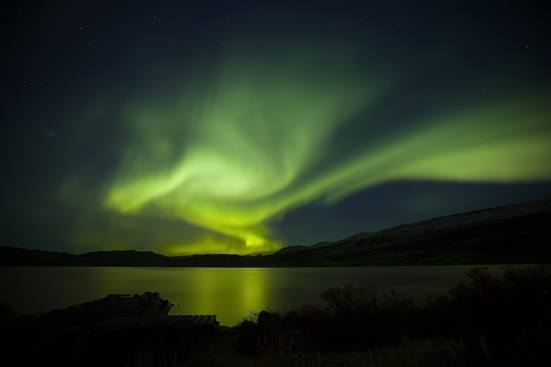Nature and wildlife
Northern lights on a Greenlandic night sky.
A host of colours and compositions are frequently illuminating the Greenlandic night sky.
The phenomenon is called northern lights or aurora borealis and is caused by the collision of energetic charged particles with atoms in high altitude atmosphere. This collision gives the sky its characteristic and powerful colours that mirror the composition of the atmosphere.
Greenland is one of the few places in the world, where you can experience this impressive dance of lights on the night sky.
In the mythical world of the Inuit the northern light was seen as a messenger between the living and the dead, and therefore it had to be treated with respect and reverence. By whistling at the aurora borealis it was possible to make contact with the dead and the aurora would answer with crackling sounds when connection was established. According to another old legend, the aurora borealis is the dead playing football with a walrus skull.
The Arctic nature is best experienced from a dogsled is. It is an adventure of speed, teamwork and magnificent scenery.
Dogsledding can be enjoyed on the west coast north of the Arctic Circle and on Greenland’s east coast. On Disko Island it is possible to dogsled on a glacier 800 metres above the town of Qeqertarsuaq, and around Easter (which often falls in March or April) North Greenland hosts an annual dogsled race.
Polar bear on the Greenlandic inland ice.(Photo:Staffan Widstrand)
Beside the magnificent sceneries, Greenland is known for its spectacular wild life. There are about 225 known species of fish and shell fish in the waters surrounding Greenland. Of the sea mammals the most important are the ringed seal, the bearded seal, the harp seal, the hooded seal, the common seal and the walrus. The Greenlandic waters are also habitat for a wide variety of whales. All the whale species of the North Atlantic come to the waters of Greenland at some point or another to breed and eat.
Greenland’s isolated location has impeded the immigration of wild land mammals. In fact Greenland only has seven species of wild land mammals: the polar bear, the polar hare, the Arctic fox, the reindeer, the musk ox, the lemming and the wolf. Accordingly there is a very scarce selection of small land mammals, and many animal groups are not represented at all – e.g. amphibians and reptiles. Certain groups of insects are under-represented as well. For instance Greenland has no ants, no grasshoppers, no dragonflies and no wasps.
To read more about the nature and wildlife of Greenland, visit:
https://visitgreenland.com/about-greenland/#nature
A humpback swimming the seas of Greenland. (Photo:Julie Skotte)



